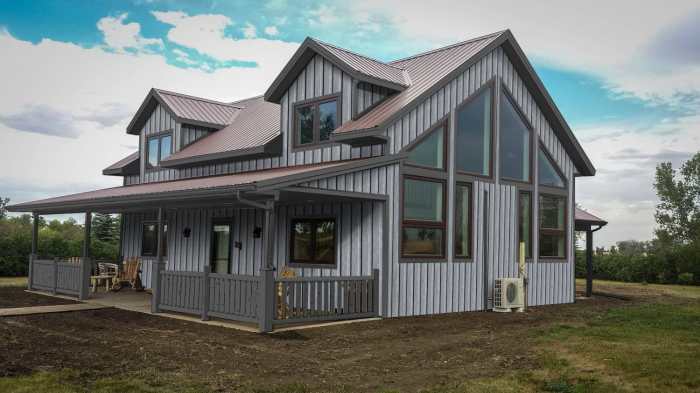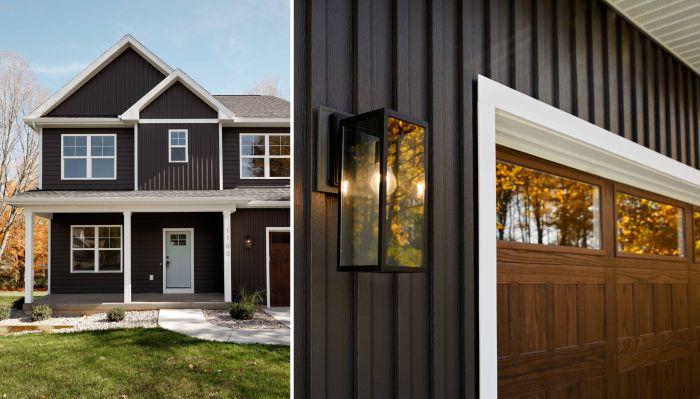As we delve into the world of metal siding for houses, we uncover a wealth of information that showcases the versatility and durability of this construction material. From installation processes to design options, this guide will equip you with everything you need to know about metal siding for your home.
Introduction to Metal Siding for Houses
Metal siding is a popular choice for residential construction due to its durability, low maintenance, and modern aesthetic appeal. It is typically made from aluminum, steel, or other metals, providing a protective layer for the exterior of a house.Metal siding offers several benefits over traditional materials like wood or vinyl.
It is resistant to fire, pests, and rot, making it a long-lasting option for homeowners. Additionally, metal siding is eco-friendly, as it can be recycled after use, reducing waste in landfills.
Types of Metal Siding
- Steel Siding: Known for its strength and durability, steel siding is a popular choice for areas prone to harsh weather conditions.
- Aluminum Siding: Lightweight and easy to install, aluminum siding is corrosion-resistant and ideal for coastal regions.
- Copper Siding: While more expensive, copper siding offers a unique and elegant look that develops a natural patina over time.
- Zinc Siding: Durable and low-maintenance, zinc siding is known for its longevity and modern appearance.
Installation Process

Metal siding can be a durable and attractive option for houses, but proper installation is key to ensuring its longevity and effectiveness. Here is a step-by-step guide to installing metal siding on a house:
Gather Necessary Tools and Materials
Before starting the installation process, make sure you have the following tools and materials on hand:
- Metal siding panels
- Measuring tape
- Tin snips
- Level
- Screws or nails
- Drill or hammer
- Siding trim pieces
- Corner pieces
- J-channel
- House wrap
- Safety goggles and gloves
Prepare the Surface
Ensure that the surface of the house is clean, smooth, and free of any debris or obstacles. Install house wrap to provide an additional layer of protection against moisture.
Install the Starter Strip
Begin by installing a starter strip along the bottom of the wall to provide a secure base for the first row of siding panels.
Attach the Siding Panels
Overlap each siding panel slightly and secure them in place using screws or nails. Make sure to leave room for expansion and contraction.
Add Trim Pieces and Corner Pieces
Finish off the edges and corners of the siding with trim pieces and corner pieces to create a polished look and ensure proper sealing.
Install J-Channel
Use J-channel around windows, doors, and other openings to provide a clean and finished appearance while allowing for movement.
Final Checks
Once all panels are installed, double-check for any loose or misaligned pieces. Make any necessary adjustments to ensure a tight and secure fit.
Tip: Avoid over-tightening screws or nails to prevent warping or damaging the metal siding.
Maintenance and Care

Metal siding is a durable and low-maintenance option for houses, but it still requires some care to ensure it remains in top condition for many years to come. Here are some tips on how to properly maintain and care for metal siding.
Regular Cleaning
- Regularly wash the metal siding with a mixture of mild detergent and water to remove dirt, dust, and grime.
- Rinse the siding thoroughly with clean water to prevent soap residue buildup.
- Avoid using abrasive materials or harsh chemicals that could damage the finish of the metal.
Preventing Rust
- Inspect the metal siding for any signs of rust or corrosion regularly.
- Apply a fresh coat of paint or sealant to any areas where the paint has chipped or worn away to prevent rust from forming.
- Keep vegetation and debris away from the siding to prevent moisture buildup, which can lead to rust.
Addressing Scratches and Dents
- For minor scratches, use touch-up paint that matches the color of the siding to cover them up.
- For dents, gently hammer them out from the backside of the siding to restore the smooth surface.
- If the damage is extensive, consider replacing the affected panels to maintain the overall appearance of the siding.
Professional Inspection
- Have a professional inspect the metal siding periodically to check for any signs of damage or wear that may require repairs.
- Addressing any issues early can prevent them from worsening and potentially causing more significant damage to the siding.
Regular maintenance and care of metal siding can help prolong its lifespan and keep your home looking beautiful for years to come.
Design Options
Metal siding offers a variety of design options that can enhance the overall look of a house. From traditional styles to modern finishes, metal siding can complement any architectural design.Metal siding comes in different textures, colors, and profiles, allowing homeowners to choose the best option that suits their preferences and the style of their home.
Some popular design options include vertical panels, horizontal lap siding, and even metal shingles that mimic the look of traditional roofing materials.Metal siding can be painted in a wide range of colors, providing endless possibilities for customization. Whether you prefer a bold and modern look or a more subtle and traditional aesthetic, metal siding can be tailored to match your style.
Comparison with Other Siding Materials
Metal siding stands out from other popular siding materials like vinyl, wood, or fiber cement due to its durability, low maintenance, and unique aesthetic appeal. While vinyl siding may offer affordability and easy installation, metal siding provides a sleek and modern finish that can elevate the curb appeal of a house.When compared to wood siding, metal siding offers better resistance to pests, rot, and fire, making it a more durable option in the long run.
Additionally, metal siding requires minimal maintenance and can last for decades without needing frequent repairs or replacements.
Enhancing the Overall Look of a House
Metal siding can enhance the overall look of a house by adding a touch of sophistication and contemporary style. Its clean lines, smooth finishes, and versatility in design make it a popular choice among homeowners looking to upgrade the appearance of their homes.Whether used as an accent feature or as the main siding material, metal siding can instantly transform the exterior of a house and increase its curb appeal.
With the right design options and color choices, metal siding can create a striking visual impact that sets a house apart from the rest of the neighborhood.
Cost Considerations

Metal siding for houses can be a durable and attractive option, but it's important to consider the costs involved before starting a project. Here, we will break down the key cost factors associated with choosing metal siding, compare its costs with other siding materials, and provide tips on budgeting effectively for your project.
Cost Factors Associated with Metal Siding
- Material Costs: The cost of the metal siding itself can vary depending on the type of metal used, such as aluminum, steel, or copper.
- Installation Costs: Hiring professionals for installation can add to the overall cost, especially if there are intricate designs or custom fittings required.
- Maintenance Costs: While metal siding is low maintenance, occasional cleaning and inspections may be needed, adding to long-term costs.
- Energy Efficiency: Consider the energy-saving benefits of metal siding, which can impact your utility bills in the long run.
Comparison with Other Siding Materials
- Wood Siding: Metal siding is generally more expensive than wood siding upfront but may require less maintenance over time.
- Vinyl Siding: Metal siding tends to be more expensive than vinyl siding but offers greater durability and a longer lifespan.
- Fiber Cement Siding: While fiber cement siding is a durable option, metal siding can provide a more modern aesthetic and may have a comparable or lower cost.
Tips for Budgeting Effectively
- Get Multiple Quotes: Compare prices from different suppliers and contractors to ensure you're getting a competitive rate.
- Consider Long-Term Costs: Factor in maintenance and energy efficiency savings when calculating the overall cost of metal siding.
- Plan for Contingencies: Set aside a buffer in your budget for unexpected expenses or changes in the project scope.
- DIY vs. Professional Installation: Evaluate whether you have the skills and tools to install metal siding yourself or if hiring professionals is the more cost-effective option.
Outcome Summary
In conclusion, metal siding offers a plethora of benefits for homeowners looking for a reliable and stylish option for their houses. With proper maintenance and care, it can stand the test of time while enhancing the overall aesthetic appeal of any property.
General Inquiries
What are the benefits of choosing metal siding over other materials?
Metal siding is known for its durability, low maintenance requirements, and resistance to elements such as fire and insects.
How can I prolong the lifespan of my metal siding?
Regular cleaning, inspections for damage, and prompt repairs can help extend the lifespan of metal siding.
What design options are available with metal siding?
From traditional to modern styles, metal siding offers a variety of colors and textures to suit different architectural preferences.
Is metal siding more expensive than other siding materials?
While the initial cost of metal siding may be higher, its durability and low maintenance can result in long-term cost savings.
























